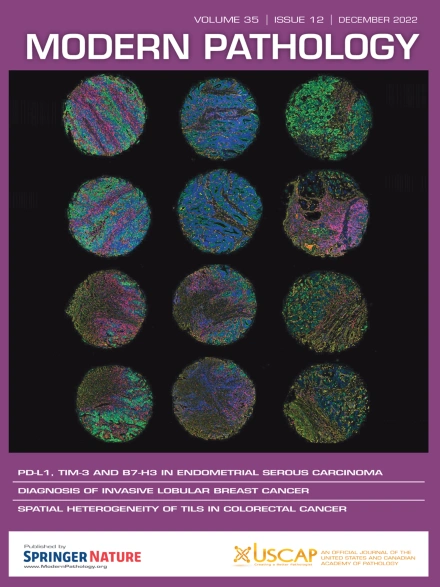良性乳腺疾病活检图像的空间分辨单细胞形态测定揭示了预测随后浸润性乳腺癌风险的定量细胞形态特征
IF 7.1
1区 医学
Q1 PATHOLOGY
引用次数: 0
摘要
目前,良性乳腺疾病(BBD)的病理分类和浸润性乳腺癌(BC)的风险评估是基于定性上皮变化,对于低风险类BBD(即非增殖性疾病[NPD]和非异型性增殖性疾病[PDWA])的女性,BC风险分层的实用性有限。在这里,基于机器学习的单细胞形态学被用来表征上皮细胞核形态学的定量变化,这些变化反映了功能/结构的下降(即,核大小增加,评估为上皮核面积和核周长),DNA染色质含量改变(即,核染色质增加),以及细胞拥挤/增殖增加(即,核轮廓不规则性增加)。用间质细胞密度评估反映慢性间质炎症的细胞形态学改变。数据和病理资料来自一项病例对照研究(n = 972),该研究纳入了Kaiser Permanente Northwest(1971-2012)诊断为BBD的15,395名女性。使用多变量逻辑回归评估细胞形态特征与后续BC风险之间的比值比(ORs)和95%置信区间(CIs)。在972张BBD图像中分析了超过5500万个上皮细胞和3700万个基质细胞。细胞形态特征独立于BBD的组织学分类,可单独预测随后的BC风险。然而,上皮功能/结构下降的细胞形态特征在统计学上显著预测PDWA后低级别BC,但不能预测高级别BC(低级别BC的OR为核面积和核周长每增加1-SD, 2.10;95% CI, 1.26-3.49和2.22;95% CI分别为1.30-3.78),而间质炎症可预测NPD后的高级别BC,但不能预测低级别BC(间质细胞密度每增加1-SD,高级别BC的OR为1.53;95% ci, 1.13-2.08)。核染色质和核轮廓不均匀与随后的肿瘤分级的关联是特定于环境的,这两个特征都预测PDWA后低级别BC风险(OR / 1-SD, 1.58;95% CI, 1.06-2.35和2.21;95% CI, 1.25-3.91,分别为核染色质和核轮廓不规则)和NPD后的高级别BC (OR / 1-SD, 1.47;95% CI, 1.11-1.96和1.29;95% CI, 1.00-1.70,分别为核染色质和核轮廓不规则)。结果表明,苏木精-伊红染色图像上的细胞形态特征可能有助于改进BBD风险评估,并可能为BBD患者提供降低BC风险的策略,特别是那些目前被指定为低风险的患者。本文章由计算机程序翻译,如有差异,请以英文原文为准。
Spatially Resolved Single-Cell Morphometry of Benign Breast Disease Biopsy Images Uncovers Quantitative Cytomorphometric Features Predictive of Subsequent Invasive Breast Cancer Risk
Currently, benign breast disease (BBD) pathologic classification and invasive breast cancer (BC) risk assessment are based on qualitative epithelial changes, with limited utility for BC risk stratification for women with lower-risk category BBD (ie, nonproliferative disease [NPD] and proliferative disease without atypia [PDWA]). Here, machine learning–based single-cell morphometry was used to characterize quantitative changes in epithelial nuclear morphology that reflect functional/structural decline (ie, increasing nuclear size, assessed as epithelial nuclear area and nuclear perimeter), altered DNA chromatin content (ie, increasing nuclear chromasia), and increased cellular crowding/proliferation (ie, increasing nuclear contour irregularity). Cytomorphologic changes reflecting chronic stromal inflammation were assessed using stromal cellular density. Data and pathology materials were obtained from a case-control study (n = 972) nested within a cohort of 15,395 women diagnosed with BBD at Kaiser Permanente Northwest (1971-2012). Odds ratios (ORs) and 95% confidence intervals (CIs) for associations of cytomorphometric features with risk of subsequent BC were assessed using multivariable logistic regression. More than 55 million epithelial and 37 million stromal cells were profiled across 972 BBD images. Cytomorphometric features were individually predictive of subsequent BC risk, independently of BBD histologic classification. However, cytomorphometric features of epithelial functional/structural decline were statistically significantly predictive of low-grade but not high-grade BC following PDWA (OR for low-grade BC per 1-SD increase in nuclear area and nuclear perimeter, 2.10; 95% CI, 1.26-3.49, and 2.22; 95% CI, 1.30-3.78, respectively), whereas stromal inflammation was predictive of high-grade but not low-grade BC following NPD (OR for high-grade BC per 1-SD increase in stromal cellular density, 1.53; 95% CI, 1.13-2.08). Associations of nuclear chromasia and nuclear contour irregularity with subsequent tumor grade were context specific, with both features predicting low-grade BC risk following PDWA (OR per 1-SD, 1.58; 95% CI, 1.06-2.35, and 2.21; 95% CI, 1.25-3.91, for nuclear chromasia and nuclear contour irregularity, respectively) and high-grade BC following NPD (OR per 1-SD, 1.47; 95% CI, 1.11-1.96, and 1.29; 95% CI, 1.00-1.70, for nuclear chromasia and nuclear contour irregularity, respectively). The results indicate that cytomorphometric features on BBD hematoxylin-eosin–stained images might help to refine BC risk estimation and potentially inform BC risk reduction strategies for BBD patients, particularly those currently designated as low risk.
求助全文
通过发布文献求助,成功后即可免费获取论文全文。
去求助
来源期刊

Modern Pathology
医学-病理学
CiteScore
14.30
自引率
2.70%
发文量
174
审稿时长
18 days
期刊介绍:
Modern Pathology, an international journal under the ownership of The United States & Canadian Academy of Pathology (USCAP), serves as an authoritative platform for publishing top-tier clinical and translational research studies in pathology.
Original manuscripts are the primary focus of Modern Pathology, complemented by impactful editorials, reviews, and practice guidelines covering all facets of precision diagnostics in human pathology. The journal's scope includes advancements in molecular diagnostics and genomic classifications of diseases, breakthroughs in immune-oncology, computational science, applied bioinformatics, and digital pathology.
 求助内容:
求助内容: 应助结果提醒方式:
应助结果提醒方式:


